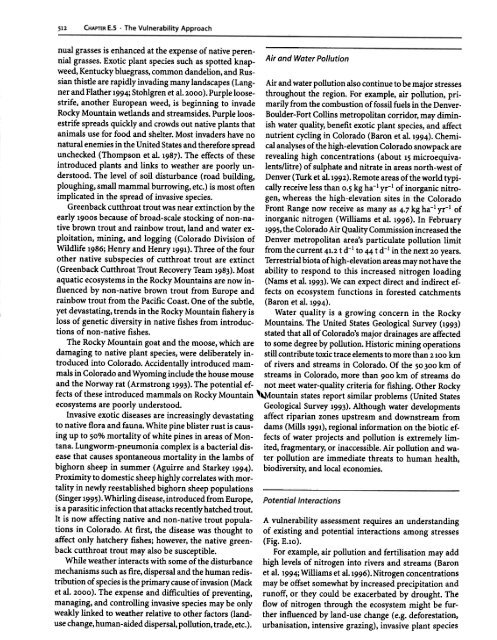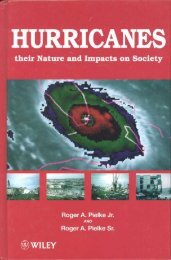How to evaluate vulnerability in changing environmental conditions
How to evaluate vulnerability in changing environmental conditions
How to evaluate vulnerability in changing environmental conditions
Create successful ePaper yourself
Turn your PDF publications into a flip-book with our unique Google optimized e-Paper software.
512<br />
CHAPTER E.5 .The Vulnerability Approach<br />
nual grasses is enhanced at the expense of native perennial<br />
grasses. Exotic plant species such as spotted knapweed,<br />
Kentucky bluegrass, common dandelion, and Rus-<br />
Air and Water Pollution<br />
sian thistle are rapidly <strong>in</strong>vad<strong>in</strong>g many landscapes (Lang- Air and water pollution also cont<strong>in</strong>ue <strong>to</strong> be major stresses<br />
ner and Flather 1994; S<strong>to</strong>hlgren et al. 2000). Purple loose- throughout the region. For example, air pollution, pristrife,<br />
another European weed, is beg<strong>in</strong>n<strong>in</strong>g <strong>to</strong> <strong>in</strong>vade marily from the combustion of fossil fuels <strong>in</strong> the Denver-<br />
Rocky Mounta<strong>in</strong> wetlands and streams ides. Purple loos- Boulder-Fort Coll<strong>in</strong>s metropolitan corridor, may dim<strong>in</strong>estrife<br />
spreads quickly and crowds out native plants that ish water quality, benefit exotic plant species, and affect<br />
animals use for food and shelter. Most <strong>in</strong>vaders have no nutrient cycl<strong>in</strong>g <strong>in</strong> Colorado (Baron et al. 1994). Chemi-<br />
natural enemies <strong>in</strong> the United States and therefore spread cal analyses of the high-elevation Colorado snowpack are<br />
unchecked (Thompson et al. 198]). The effects of these reveal<strong>in</strong>g high concentrations (about 15 microequiva-<br />
<strong>in</strong>troduced plants and l<strong>in</strong>ks <strong>to</strong> weather are poorly unlents/litre) of sulphate and nitrate <strong>in</strong> areas north-west of<br />
ders<strong>to</strong>od. The level of soil disturbance (road build<strong>in</strong>g, Denver (Turk et al.1992). Remote areas of the world typi-<br />
plough<strong>in</strong>g, small mammal burrow<strong>in</strong>g, etc.) is most often cally receive less than 0.5 kg ha-l yr-l of <strong>in</strong>organic nitro-<br />
implicated <strong>in</strong> the spread of <strong>in</strong>vasive species.<br />
gen, whereas the high-elevation sites <strong>in</strong> the Colorado<br />
Greenback cutthroat trout was near ext<strong>in</strong>ction by the Front Range now receive as many as 4.7 kg ha-l yr-l of<br />
early 1900S because of broad-scale s<strong>to</strong>ck<strong>in</strong>g of non-native<br />
brown trout and ra<strong>in</strong>bow trout, land and water ex-<br />
<strong>in</strong>organic nitrogen (Williams et al. 1996). In February<br />
1995, the Colorado Air Quality Commission <strong>in</strong>creased the<br />
ploitation, m<strong>in</strong><strong>in</strong>g, and logg<strong>in</strong>g (Colorado Division of Denver metropolitan area's particulate pollution limit<br />
Wildlife 1986; Henry and Henry 1991). Three of the four from the current 41.2 t d-l <strong>to</strong> 44 t d-l <strong>in</strong> the next 20 years.<br />
other native subspecies of cutthroat trout are ext<strong>in</strong>ct Terrestrial biota of high-elevation areas may not have the<br />
(Greenback Cutthroat Trout Recovery Team 1983). Most ability <strong>to</strong> respond <strong>to</strong> this <strong>in</strong>creased nitrogen load<strong>in</strong>g<br />
aquatic ecosystems <strong>in</strong> the Rocky Mounta<strong>in</strong>s are now <strong>in</strong>- (Nams et al. 1993). We can expect direct and <strong>in</strong>direct effluenced<br />
by non-native brown trout from Europe and fects on ecosystem functions <strong>in</strong> forested catchments<br />
ra<strong>in</strong>bow trout from the Pacific Coast. One of the subtle, (Baron et al. 1994).<br />
yet devastat<strong>in</strong>g, trends <strong>in</strong> the Rocky Mounta<strong>in</strong> fishery is Water quality is a grow<strong>in</strong>g concern <strong>in</strong> the Rocky<br />
loss of genetic diversity <strong>in</strong> native fishes from <strong>in</strong>troduc- Mounta<strong>in</strong>s. The United States Geological Survey (1993)<br />
tions of non-native fishes.<br />
stated that all of Colorado's major dra<strong>in</strong>ages are affected<br />
The Rocky Mounta<strong>in</strong> goat and the moose, which are <strong>to</strong> some degree by pollution. His<strong>to</strong>ric m<strong>in</strong><strong>in</strong>g operations<br />
damag<strong>in</strong>g <strong>to</strong> native plant species, were deliberately <strong>in</strong>- still contribute <strong>to</strong>xic trace elements <strong>to</strong> more than 2 100 km<br />
troduced <strong>in</strong><strong>to</strong> Colorado. Accidentally <strong>in</strong>troduced mam- of rivers and streams <strong>in</strong> Colorado. Of the 50300 km of<br />
mals <strong>in</strong> Colorado and Wyom<strong>in</strong>g <strong>in</strong>clude the house mouse streams <strong>in</strong> Colorado, more than 900 km of streams do<br />
and the Norway rat (Armstrong 1993). The potential ef- not meet water-quality criteria for fish<strong>in</strong>g. Other Rocky<br />
fects of these <strong>in</strong>troduced mammals on Rocky Mounta<strong>in</strong>' 'I\1ounta<strong>in</strong> states report similar problems (United States<br />
ecosystems are poorly unders<strong>to</strong>od.<br />
Invasive exotic diseases are <strong>in</strong>creas<strong>in</strong>gly devastat<strong>in</strong>g<br />
Geological Survey 1993). Although water developments<br />
affect riparian zones upstream and downstream from<br />
<strong>to</strong> native flora and fauna. White p<strong>in</strong>e blister rust is caus- dams (Mills 1991), regional <strong>in</strong>formation on the biotic ef<strong>in</strong>g<br />
up <strong>to</strong> 50% mortality of white p<strong>in</strong>es <strong>in</strong> areas of Monfects of water projects and pollution is extremely limtana.<br />
Lungworm-pneumonia complex is a bacterial disited, fragmentary, or <strong>in</strong>accessible. Air pollution and waease<br />
that causes spontaneous mortality <strong>in</strong> the lambs of ter pollution are immediate threats <strong>to</strong> human health,<br />
bighorn sheep <strong>in</strong> summer (Aguirre and Starkey 1994).<br />
Proximity <strong>to</strong> domestic sheep highly correlates with mortality<br />
<strong>in</strong> newly reestablished bighorn sheep populations<br />
biodiversity, and local economies.<br />
(S<strong>in</strong>ger 1995). Whirl<strong>in</strong>g disease, <strong>in</strong>troduced from Europe,<br />
is a parasitic <strong>in</strong>fection that attacks recently hatched trout.<br />
Potential Interactions<br />
It is now affect<strong>in</strong>g native and non-native trout popula- A <strong>vulnerability</strong> assessment requires an understand<strong>in</strong>g<br />
tions <strong>in</strong> Colorado. At first, the disease was thought <strong>to</strong> of exist<strong>in</strong>g and potential <strong>in</strong>teractions among stresses<br />
affect only hatchery fishes; however, the native greenback<br />
cutthroat trout may also be susceptible.<br />
(Fig. E.10).<br />
For example, air pollution and fertilisation may add<br />
While weather <strong>in</strong>teracts with some of the disturbance high levels of nitrogen <strong>in</strong><strong>to</strong> rivers and streams (Baron<br />
mechanisms such as fire, dispersal and the human redis- et al. 1994; Williams et al.1996). Nitrogen concentrations<br />
tribution of species is the primary cause of <strong>in</strong>vasion (Mack may be offset somewhat by <strong>in</strong>creased precipitation and<br />
et al. 2000). The expense and difficulties of prevent<strong>in</strong>g, runoff, or they could be exacerbated by drought. The<br />
manag<strong>in</strong>g, and controll<strong>in</strong>g <strong>in</strong>vasive species may be only flow of nitrogen through the ecosystem might be fur-<br />
weakly l<strong>in</strong>ked <strong>to</strong> weather relative <strong>to</strong> other fac<strong>to</strong>rs (landther <strong>in</strong>fluenced by land-use change (e.g. deforestation,<br />
use change, human-aided dispersal, pollution, trade, etc.). urbanisation, <strong>in</strong>tensive graz<strong>in</strong>g), <strong>in</strong>vasive plant species














